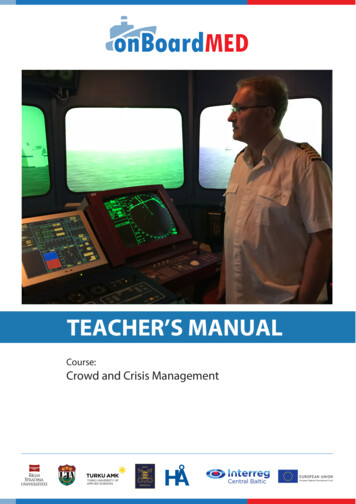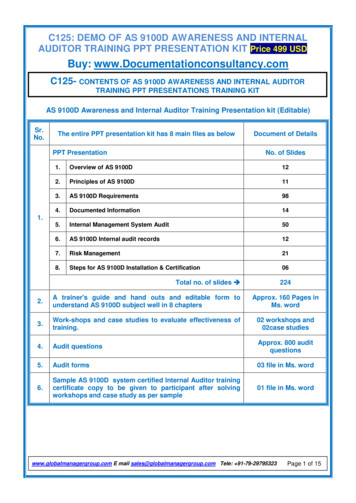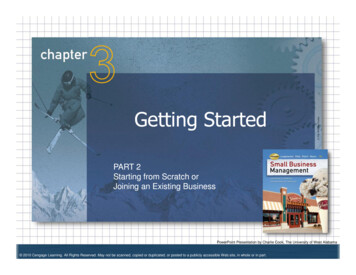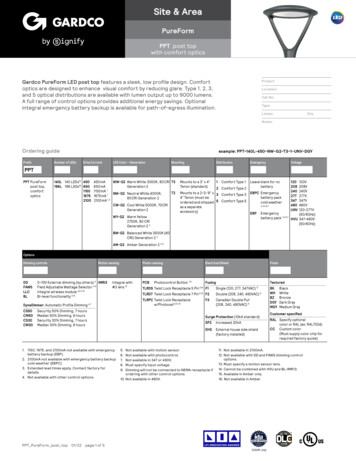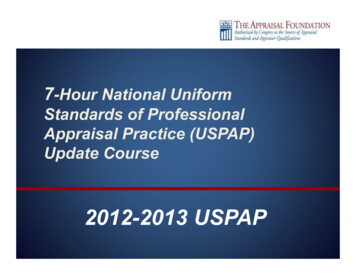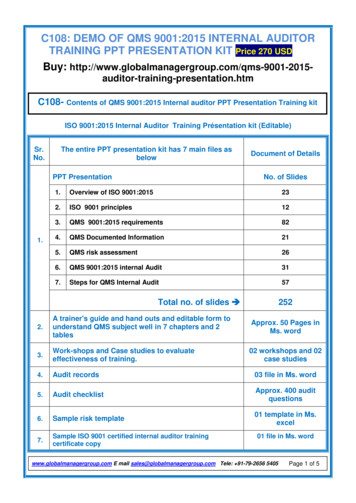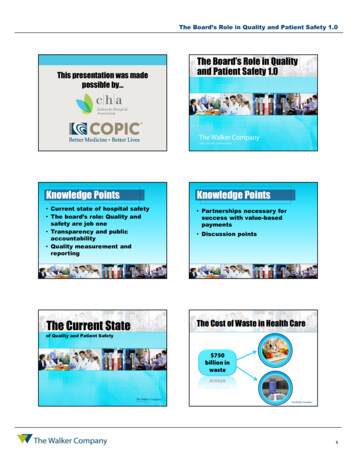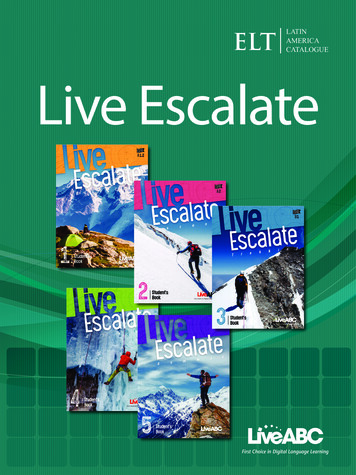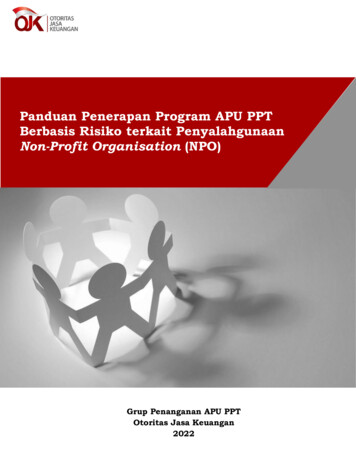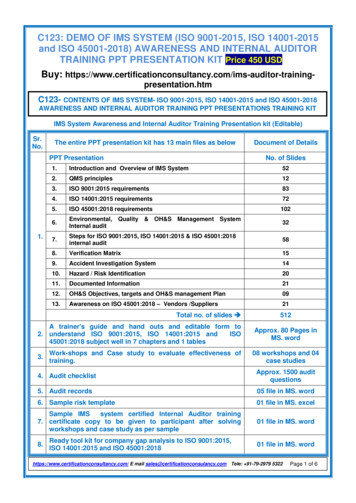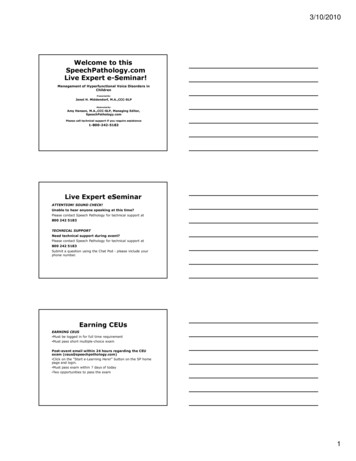
Transcription
3/10/2010Welcome to thisSpeechPathology.comLive Expert e-Seminar!Management of Hyperfunctional Voice Disorders inChildrenPresented By:Janet H. Middendorf, M.A.,CCC-SLPModerated By:Amy Hansen, M.A.,CCC-SLP, Managing Editor,SpeechPathology.comPlease call technical support if you require assistance1-800-242-5183Live Expert eSeminarATTENTION! SOUND CHECK!Unable to hear anyone speaking at this time?Please contact Speech Pathology for technical support at800 242 5183TECHNICAL SUPPORTNeed technical support during event?Please contact Speech Pathology for technical support at800 242 5183Submit a question using the Chat Pod - please include yourphone number.Earning CEUsEARNING CEUS Must be logged in for full time requirement Must pass short multiple-choice examPost-event email within 24 hours regarding the CEUexam (ceus@speechpathology.com) Click on the “Start e-Learning Here!” button on the SP homepage and login. Must pass exam within 7 days of today Two opportunities to pass the exam1
3/10/2010Peer Review ProcessInterested in Becoming a Peer Reviewer?APPLY TODAY! 3 years SLP Clinical experienceRequired Contact: Amy Hansen atahansen@speechpathology.comSending QuestionsType question or commentand click the send buttonDownload HandoutsClick to highlight handoutClick Save to My Computer2
3/10/2010Management of PediatricHyperfunctional VoiceDisordersJanet H. Middendorf, M.A.,CCCCincinnati Children’s Hospital Medical CenterDivision of Speech PathologyPediatric Voice CenterMarch 11, 2010SpeechPathology.comTerminology Hyperfunction: Result of increased and poorlyregulated laryngeal muscle tension. Imbalances and increases in muscle tensionPhonotrauma Abuse or misuse of the vocal foldsAccumulated stress of vibration on vocal foldsCan result in development of lesions such asvocal fold nodulesVocal Abuse Suggests: Child is intentionally abusing his\her voiceChild has an abusive personalityChild is verbally abusive to othersChild is being yelled out by othersTherefore: Term Phonotrauma is suggested3
3/10/2010Prior to Voice Therapy Assessment by ENT and speech-languagepathologistLaryngeal assessment Endoscopic Rigid or flexible scopeRule (confirm) out laryngeal pathologyAcoustic assessmentAerodynamic assessmentPerceptual assessmentCommon Findings in HyperfunctionalVoice DisordersVocal fold edemaVocal fold nodules Hour glass configuration Site of nodules is locationof brunt of impactAllows air to escapeDecreased voicing timeDysphonia breathinesshoarsenessElements of Normal (best) Vocal FoldVibration Ability of vocal folds to adduct or closeConsistent air flow - air pressurePliable vocal folds (mucosa covering)Barely adducted or abducted vocal folds Maximum vocal economyVerdolini, et al 1998, Journal of Voice, Laryngeal Adduction in Resonant Voice4
3/10/2010Value of a Good History Parent’s perception of voice concernsChild’s voice usageObservation of parent’s voice usageChild’s environment Home SportsBehaviorSchoolInformal Assessment Describe/rate voice CAPE-V * overall, roughness, breathiness, pitch, loudnessQuick Screen for Voice **StrainMaximum phonation timeRecord vs/D3CAPEVprocedures.pdf**Stemple, J, Glaze, L., Kelchner, L, Quick Screen for Voice and Supplementary Documents for Identifying PediatricVoice Disorders, LSHSS, Vol 35Treatment Strategies5
3/10/2010Parent Involvement Is essential for home practiceIs essential for compliance Many families have their ownpatterns of phono- traumaThey need to buy into the conceptIs essential for carryoverNeed to understand rationale fortreatmentTypes of Voice Therapy Indirect (behavior management) Vocal hygieneIdentify and eliminate vocal traumatic behaviorsImprove hydrationNoisy environmentDiet associated with refluxDirect (hands on) ExercisesIndirect Voice Therapy Identify – Eliminate Phonotrauma Shouting, yelling, throat clearing, loud whispering,grunting during exercise, smokingOveruse of voiceHydrationReflux precautions6
3/10/2010Substitute Behaviorsfor Phonotrauma Using a loud voice oryelling to getsomeone’s attention Have child walk tolistener Chart the number oftraumatic behaviors (?)Rehearse behavior priorto needChart behaviorReward behaviorSubstitute Behaviors Yelling and screamingduring play activities Use soft voice duringplay?Teach child to projectloud voiceUse a front focusTeach child to “shout”Substitute Behaviors Talking loud overcompetingbackground noises Turn down music or TVUse preferential seatingUse ear plug(s) Decreases urge to increasevocal intensity to hear selfWill hear self better with earplugsGreat on playground7
3/10/2010Chart Vocal BehaviorsType of phonotraumaShouting,screamingMotor soundsWednesdayThursdayAnimal, superhero soundsExcessive talkingThroat clearingChart Vocal SuccessesType of phonotraumaShouting,screamingMotor soundsWednesdayThursdayWalked to momBuzzed lipsAnimal, superPut cape on myhero soundsback and “flew”Excessive talking Sent secret noteThroat clearingDrank waterslowlySubstitute Behaviors Throat Clearing Vocal folds closeVibrate in a highfriction mannerLong hard swallow Vocal folds closeRemain closed for afew secondsGives larynx feedbackthat they have been“together” but in an nontraumatic mannerIncrease hydration8
3/10/2010Hydration Dehydration results inincreased subglottic airpressure, which results inincreased tension, strain,hyperfunctionWell hydrated vocal foldsrequire less subglottic airpressure to vibrateLikelihood of edematoustissue reaction should beminimizedHydration-Why Helpful to Voice Decreased subglottic air pressure results indecreased tension, strain, aiming towardsmore balanced function Reduction in tension results in reducedhyperfunctionLess work to phonate - makes voicing easier!Hydration: How Much and What? More with sports, illness, medications1\2 of normal body weight in ounces (i.e. 100lb person should consume 50 Oz fluid perday)Water, sports drinksNon citrus drink (non citrus in case of reflux)“Wet” snacks – fruits and vegetables9
3/10/2010Water is Source of Lubrication If hinges of door arenot well lubricated Takes extra effortIf hinges are welllubricated Can use finger to set itinto motionReflux Known as: Gastric esophageal reflux disease (GERD) Extrinsic esophageal reflux Laryngopharyngeal reflux (LPR) Backward flow of digestive gastric from the stomach through theesophagus to the level of the larynxAcid in a non acidic environmentResults in irritationSymptoms Heartburn, sour taste in mouth in morning, globus, cough,“mini-throw-up” (baby barf) Reflux Precautions Change in diet Decrease carbonated, citrus drink Decrease spicy foods No food or drink 3-4 hours before bedRaise head of bedAnti-reflux medication Reduces acidity of gastric contents, does not change theactual reflux of stomach contentsNissen fundoplication10
3/10/2010Direct Voice TherapyTreatment Goal:Improve Voice Quality Reduce laryngeal hyperfunction Front focus voice productionImprove hydrationImprove diet, if neededFire SLP Child/parent assume the SLP’s roleDirect Treatment Strategy:Front Focused Phonation Vocal Function Exercises (modified as needed)Resonant Voice Therapy (modified as needed)11
3/10/2010Front Focus Rationale Titze (2006) “heighten interaction”between the source and the filterSemi-occlusion in the front of thevocal tract (at the lips) heightenssource (vocal) tract interactionTitze Review (2006 ) “Economy-oriented voice training is based on thepremise that vocal injury can be minimized ifvibration dose and collision stress in the vocal foldsare reduced.” Goal is to reduce the stress of vibration of the vocal foldsIntent is to produce voice with normal intensity with lessmechanical trauma to tissueShape of vocal track with oral cavity results in increasedenergy production without more strain on vocal folds.Theoretical Hierarchy of SemiOccluded Voice Track Highly resistant (small diameter) stirringstrawLess resistant (larger diameter) drinking strawBilabial or labiodental voiced fricativeLip or tongue trillNasal consonantsVowels /u/ and /i/(Titze, 2006)12
3/10/2010Vocal Function Exercises As modified by Joseph Stemple, Ph.D.Exercises designed to rebalance the threesubsystems of voice production: respiration,phonation and resonanceIf all are balanced, voicing is at its best and itseasiestExercises as a type of "physical therapy" forthe vocal folds(Stemple, Glaze, & Klaben, 2000)Vocal Function Exercises Four steps Warm upStretches – Glide upContractions – Glide downPower buildingPerform each 2 times2 times a dayTechnique Exercises done as softly as possibleAnchor system if needed Lip buzzTongue trillBilabial fricative (kazoo like)Make connection between lungs and lipsMake a tape/CD for the child for homepractice13
3/10/2010Warm up Sustain "E" for as long as possible on themusical note F. The production should be anasal placementWarm Up VideoStretching Glide from your lowest note to your highestnote using the word "Whoop or Knoll".* If /hw/ production is correctly produced, thesound should be vibrating the lips similar tothe sound of a kazoo and should make the lipstingle.If this is difficult to produce, try producing a"raspberry" with lips and glide up the scale.14
3/10/2010Stretching VideoContracting Glide from your highest note to your lowestnote on the word "Boom".Similar frontal placement of the sound shouldbe produced, as described above.After correctly producing the glide in thismanner, try it again using a "yawn-sigh"approach.Contracting Video15
3/10/2010Power Building Exercises Sustain the musical notes C, D, E, F, and G for aslong as possible saying the word “Old” without the“d”.The rounded posture of the lips is important whentrying to obtain the “frontal focus” of soundproduction.Depending on the child’s fundamental frequency,you may need to alter the notes.In young children, use three notes, comfortable,high, low.Power Building VideoWho Can Perform VFE? Most children can betaught Important that parentsunderstand theexercisesIt is the quality of theexercises whichcount May be too difficult forsome preschoolers But not all 16
3/10/2010VFE VideoResonant Voice Easy phonation based on voice productioninvolving sensation of oral vibrationConsidered a holistic voice therapy approachPlacement is on the anterior alveolar ridge orhigher in the face .want to feel the “buzz” Resonant Voice Therapy developed by KatherineVerdolini, based on the work of Arthur Lessacand Mark Madsen(Verdolini-Marston, Burke, Lessac, Glaze, & Caldwell, 1995)Resonant Voice Training Need training in RVTAs concept is sensory feedback Is modified for children17
3/10/2010Modify Front Focused Phonation withYounger or Developmentally DelayedChild Raspberries on lips or tongue, trill tongueBlow bubbles through wandBlow bubbles through straw in liquidBlow through kazoo, whistleTry all first without voicing to get posture,then add voicingModify Front Focused Phonation withYounger or Developmentally DelayedChild Use visual Feedback Bubble blowingwith bubble wandwith straw in cup of waterBlowing Bubbles with Phonation Video18
3/10/2010Modify Front Focused Phonation withYounger or Developmentally DelayedChild Increase difficulty withdecreased visualfeedback Phonate through strawin waterRepeat, take straw outof waterRepeat, take straw outof mouthStraw Bubbles Phonation VideoKazoo or Whistle are Good Props Use of a “prop” helps child learn the “semioccluded” position19
3/10/2010Front Focus with Whistle VideoModify Front Focused Phonation withYounger Child Make lips a Kazoo raspberriestongue trillproduce “V”produce reverse “V”produce bilabial “V”Tongue Trill Video20
3/10/2010Functional Front Focused Phonationwith Younger Child Lip buzz for truck, plane, carMMMMM for rocking baby dollAnimal sounds: cat meow, owl hoot,Read books loaded with nasal and othersemi occluded phonemes: m, n, z, v, j(Katherine Verdolini, Lessac-Madsen Resonant Therapy-Kids-Pittsburgh, PA,2006)Functional Front Focused Phonationwith Younger Child Combine resonant voice with articulationapproach Target resonant and front focus consonants andvowels m, n, z, v, y, w, u, oIsolation, words, phrases etc.Games Where are you (hide and seek)My oh my, mama may I?Carryover? Follow hierarchical principles Similar to articulation therapySyllables, words, phrases, sentences etc.Use “anchor” for semi occluded position sounds /W//O//M//N/21
3/10/2010Hierarchy of Sounds /wh/ (what, where) Syllables through sentences/h/ (who)Syllables through sentences/m/,/n/ my mom Syllables through sentencesAnd make it their own . Give child strategies to “get back” to a better, frontfocused voiceProgress of Treatment Establish front focus in phonationTeach Vocal Function Exercises to childStress importance of family involvement indaily exercise programProgress front focus technique through atypical therapy hierarchy (e.g., syllables,words, phrases, sentences, etc.)22
3/10/2010Value of Negative Practice Able to compare, contrast and identify Front vs. back focusHyperfunction (strain)Diaphragmatic vs. thoracic breath supportClassroom ManagementMake Friends with the Staff Classroom TeacherMusic TeacherScience TeacherPhysical Education TeacherAny staff member who has had (or has) vocalfold nodules)23
3/10/2010Teacher’s Involvement Music TeacherScience TeacherPE TeacherCoach/Cheerleader squadClassroom Teacher Knowledge of laryngealmechanismUnderstanding of need forwarm up exercisesGreat for involvinganatomy, physiology andphysics, refluxMotivating factor for childTeach “OK” technique for“shouting”Allowing child to bringwater bottle to classChorus and Music Teacher Voice warm ups aresimilar to vocal functionexercisesConsider letting childparticipate in warm - ups“lip sync” materialWork closely with schoolsigning teacherSinging Teacher vs. SLP ASHA suggests separate approach may not bethe best.Integrated approach most effective to optimalvoice care and production ASHANational Association of Teachers of Singing(VATS)Voice and Speech Trainers of America (VASTA)Occasionally – multispecialization24
3/10/2010What About The Child Who Wants ToSing? Trained vs. UntrainedUntrainedDiscourage for the time being as most childrenwill revert to hyperfunctionTrained: May consider allowing limited involvement Level of training School/church/community choirPre-professional training School for the Creative and Performing ArtsEnvironment Vaporize Your Classroom (no less than 20%humidity)Reduce Listener-Speaker Distances Typical adult voice is 60 dB at distance of 3feetKeep Temperature at a comfortable level (nottoo hot)Attention Getters other than voice (LightsOut, Bell, etc.)Decorate!! Hang Fabric/Cloth Class Projects and bannersto increase noise Absorption To reflect and/or absorb soundEngage the art teacher and the classroomteacher Can be an art project for class25
3/10/2010Qualifying for School Services Not easy, but possible“A child is described ashaving a voice problem ifthe voice is distracting orunpleasant to listeners andis abnormal enough tointerfere withcommunication” (Wilson,1987)Eligibility for Services Need to be within the framework of IDEAPart A- Services in educational settingPart B- Child is eligible for services if impairment “adverselyimpacts educational performance.” adversely impacts educational performance not definedOral communication is essential to classroom learningVoice difference may self limit the child’s participation inclass(Hoffman Ruddy 2004)Direct Limitations Difficulty being heard in(or out) of classroomLimited participation inclassroom presentationsReluctance to participate inschool activitiesNegative attention fromclassmates, teachersDecreases intelligibility(Hoffman Ruddy 2004)26
3/10/2010Resources Easy Does it for Voice (Linguasystems)Using your Best Voice (Moya Andrews SuperDuper)Martha Mouth and Baby Bear (book andcards) Super DuperQuestions?janet.middendorf@cchmc.org27
vocal tract (at the lips) heightens source (vocal) tract interaction Titze Review (2006 ) "Economy-oriented voice training is based on the premise that vocal injury can be minimized if vibration dose and collision stress in the vocal folds are reduced." Goal is to reduce the stress of vibration of the vocal folds
